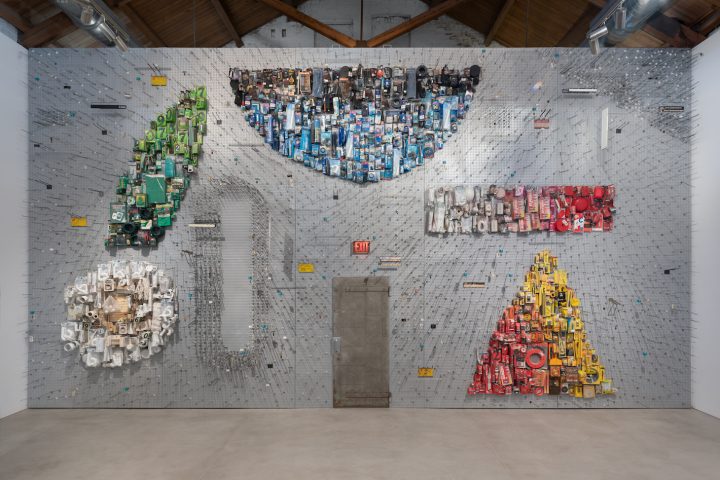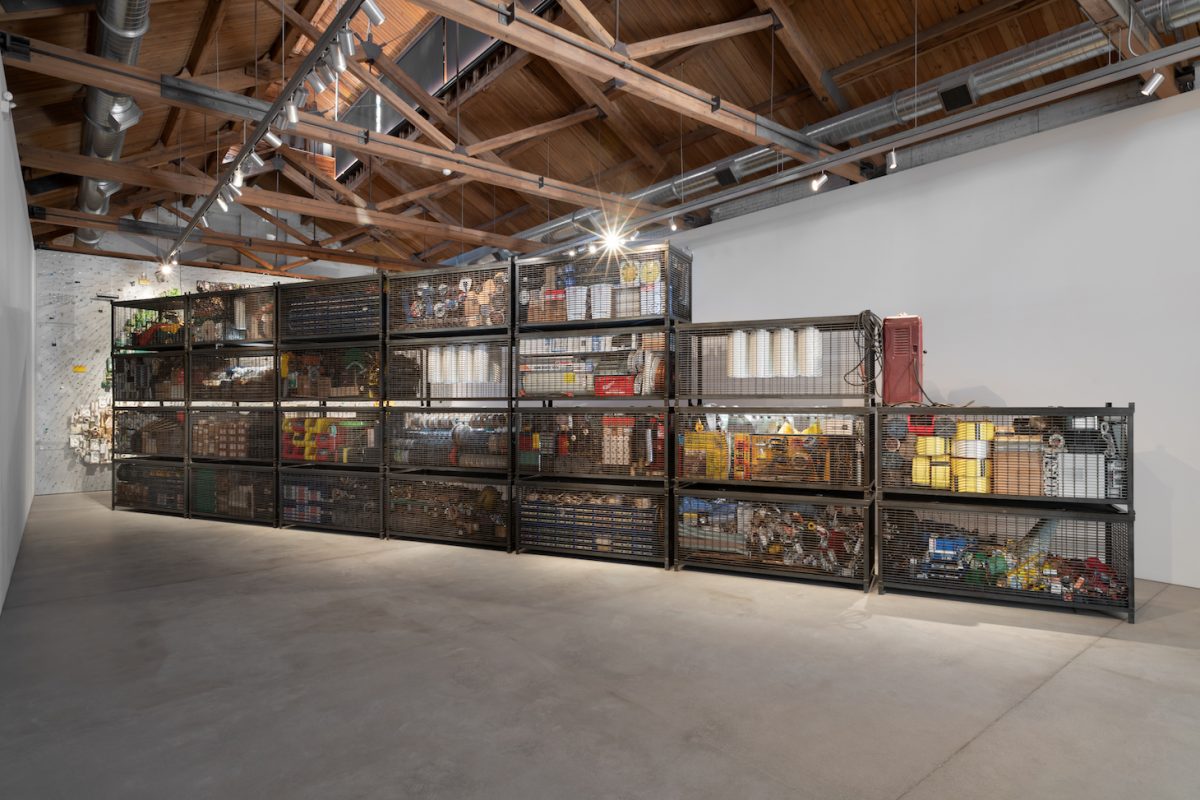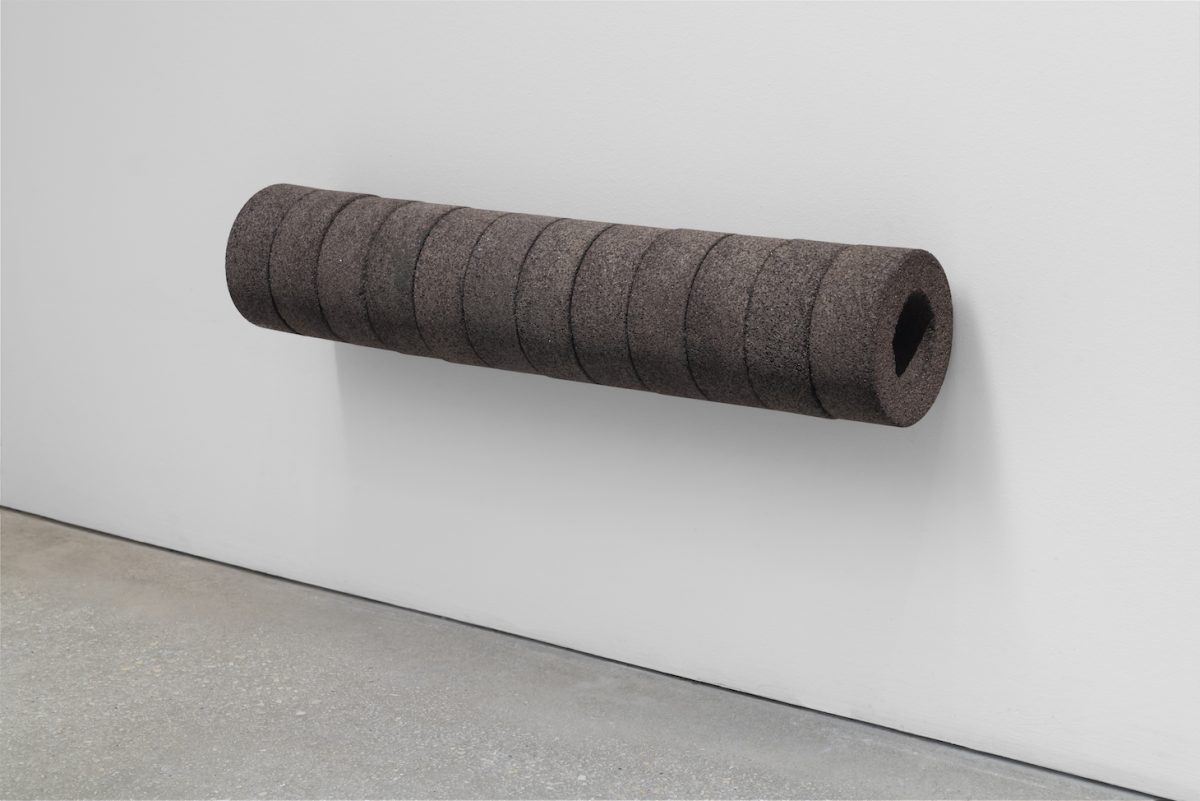
CHICAGO — A large wood-fired vase holding a spray of bright flowers greets you when you walk into How to Sell Hardware, Theaster Gates’s installation at Chicago’s Gray Warehouse. It’s a piece Gates made, and it’s a warmly welcoming gesture to viewers stepping into the austere gallery space. It also serves as a reference to the artist’s early career as a ceramicist: Gates trained as a potter, and for 15 years wood-fired vessels and other ceramic pieces were his primary means of artistic expression. The works in his new installation, composed of the contents of a defunct hardware store, seem at first to have little in common with such a traditional ceramic form. But in a sense the vessel offers a key into the themes of the show. Firing a wood kiln is a communal, intensely laborious effort, sometimes involving squads of potters tending the fire together for days on end — and How to Sell Hardware, despite the name, is less concerned with commerce than it is with the intersection of labor and community.
These themes have been central to Gates’s work for many years. “Yukata” (2010), for example, consists of a shoeshine chair made of salvaged wood, metal, and leather. The chair rises like a throne above viewers, who are invited to see themselves in the position of the shoe shiner, bending over the iron foot stands that elevate the customer’s feet. Like barber shops, shoe shine stands have often functioned as places of community interaction; and, like barbers, many shoe shiners take great pride in their work, an endeavor that is both functional and aesthetic. But their physical position, bent over the shoe of an elevated patron, cannot avoid connotations of servitude. It is significant that in the United States many shoe shiners — who, regardless of age, were for several years referred to as “shoe shine boys” — have been African American. “Yukata” expresses solidarity with a community of Black laborers whose pride in their work sat side by side with their physical and at times social subordination.

More recently, Gates has created a series of tar paintings, like “Top Heavy” (2020), that evoke Abstract Expressionism but also, via their medium, point to his father’s work as a roofer in Chicago. These works seduce the gallery-goer with visual pleasures and art historical references, before opening out onto ideas of work, community, and race.
How to Sell Hardware is Gates’s second show composed of artifacts from Chicago’s Halsted True Value Hardware, which he purchased in 2014 after it closed due to the economic decline of its neighborhood and competition from big box retailers. The first, 2016’s True Value, filled Milan’s Fondazione Prada with store inventory arrayed in color-coded rows, aestheticizing objects that were once utilitarian. How to Sell Hardware is both more ambitious and more thoroughly archival: the show includes what appears to be the entire contents of the store, from its stock of nuts and bolts to its display racks and lighting fixtures.
Simply listing the vast contents indicates the wide range of activity that took place in the once-prosperous area: PVC and metal pipes, rolls of duct tape, boxes of screws, sanding belts, plumbing fixtures, shovel handles, a large air pump. Spools of wire sit next to rolls of contact paper whose loose ends flutter in the breeze of the store’s box fan. The gathered objects evoke the sweat, skill, and self-reliant pride involved in maintaining and improving one’s home, as well as the labor of armies of contractors and tradesman like Gates’s father. Gardening tools show that an intimate relationship to the earth is possible even in urban environments. A fire extinguisher, collapsible conveyor belts for the unloading of delivery trucks, a phone, and a cash box are all reminders that this inventory wasn’t static, but was part of an active neighborhood economy.

Recognizing familiar objects offers a certain pleasure; realizing that other tools and objects may be less identifiable to many viewers prompts reflections on the perhaps distant relationship to the work that goes into property maintenance: those of us who don’t know how to use a particular tool probably depend on the labor of someone who does.
In “Retaining Wall” (2021), the largest and most commanding work in How to Sell Hardware, Gates imposes order on a cornucopia of utilitarian objects by arranging them in 25 large black gabions, the rectangular steel containers — about eight by four feet — often used to hold rocks and other kinds of fill. Gabions are generally used to reinforce landscaping walls, harbors, and other civil engineering projects; like the objects they contain in the installation, they are redolent of labor. Gates has stacked his gabions to form a massive wall that cuts across the large, high-ceilinged interior of Gray Warehouse at a diagonal, extending nearly from corner to corner. One end is low, just two gabions high, but the wall builds upward until it reaches some 12 feet in height, towering over viewers.
The overall effect is quite imposing. Like much that Gates creates, the piece has an art historical referent: in its color, scale, and obstruction of space, “Retaining Wall” echoes Richard Serra’s “Tilted Arc”(1981). This prompts thoughts about the nature of art and the public: Serra’s work was public in its initial location, New York’s Foley Federal Plaza. Gates’s work is public not in location, but rather in its neighborhood retail store origins and in the originally intended use of its various contents. It also makes one think about the labor and materials that go into a monument like Serra’s.

A surprising amount of text appears in Retaining Wall, from product packaging to store signs, to the familiar orange-and-black signs sold to home and business owners — for example, “No Smoking,” “For Sale,” and “Keep Off the Grass.” Many small dreams were served by the store, and some have certainly died with it.
The monumentality of “Retaining Wall” cannot be ignored. It is, in essence, a memorial, not only to a particular store, but to a neighborhood as it once was: striving, self-reliant, full of aspirations. The long black wall of gabions, high at one end, low at the other, also recalls Maya Lin’s Vietnam Veteran’s Memorial wall (1982). But there is an architectural aspect as well: the black grid of the gabion frames brings to mind the Miesian modernism of many of Chicago’s best known buildings. Is this an expression of local pride by Chicago-born-and-bred Gates? Is it, given the imposing nature of the piece, a comment on how architecture can function as a barrier or fortress of exclusion? That the Illinois Institute of Technology, just a few miles from the installation, is both a Mies van der Rohe masterpiece and a predominantly white institution, set in a predominantly Black neighborhood, gives credence to the latter interpretation.

Other works on display include five arrangements of hardware inventory hung on steel display pegs, on a vast pegboard covering the gallery’s back wall: “Circle,” “Leaf,” “Bowl,” “Rectangle,” and “Triangle”(all 2021). Like the work in the 2016 True Value installation in Milan, common hardware items are arranged in color-coordinated clusters. Shape and hue create visual order, and there’s a hint of Ellsworth Kelly’s shaped monochrome canvases to the works.
Again, Gates joins ideas of labor, function, and property with aesthetic and art historical concerns. “This exhibition examines my insistence that the world is not separated between high objects and low objects,” he says, quoted in the press release, “but rather, that the artist has the capacity to determine the designation of each.” Near the wall opposite these pegboard works is “History of Conveyance” (2021), a large vitrine containing an accordion conveyor — a kind of collapsible conveyor belt used in warehouses — and a copy of the 1913 Roy F. Soule book How to Sell Hardware: Successful Money Making Plans for Conducting an Up-To-Date Hardware Business, Practical Selling Ideas Used By Successful Hardware Merchants. The book doesn’t just lend the show its title: it indicates that the business from which the materials of the installation are drawn was, like the projects for which those materials were intended, someone’s enterprising venture.
One final work, “Foot Scrubber,” is easy to overlook. Set low to the ground in an inconspicuous corner, it consists of a row of rotary abrasive cylinders. It looks as if one could stick a shoe under it for a good buffing. It’s hard not to think of “Yukata” here, and its concerns with both the dignity and debasement that can accompany such labor. And it is hard, when exiting the gallery into a narrow street still filled with warehouses and laborers at work on loading docks, not to feel the separation of art and life collapse.

Theaster Gates: How to Sell Hardware continues at Gray Warehouse (2044 West Carroll Ave., Chicago, Illinois) through July 31.
0 Commentaires